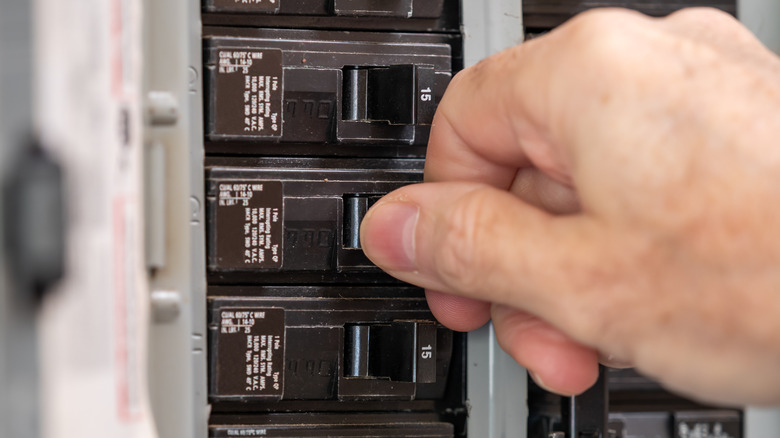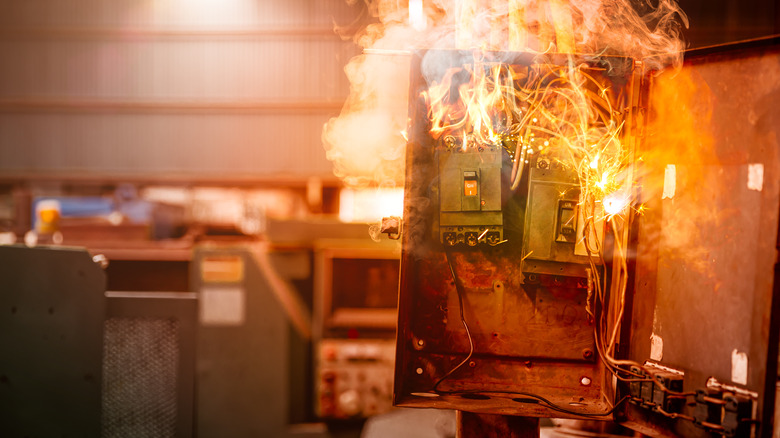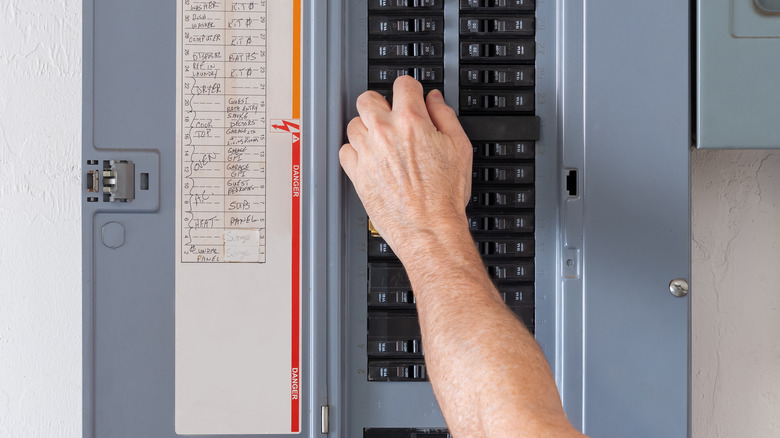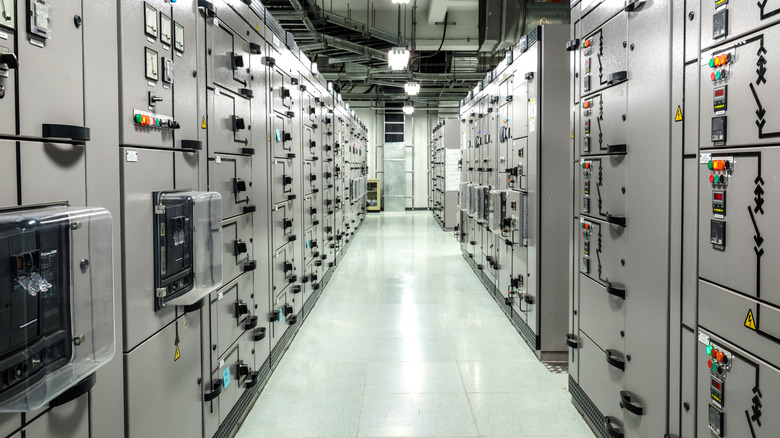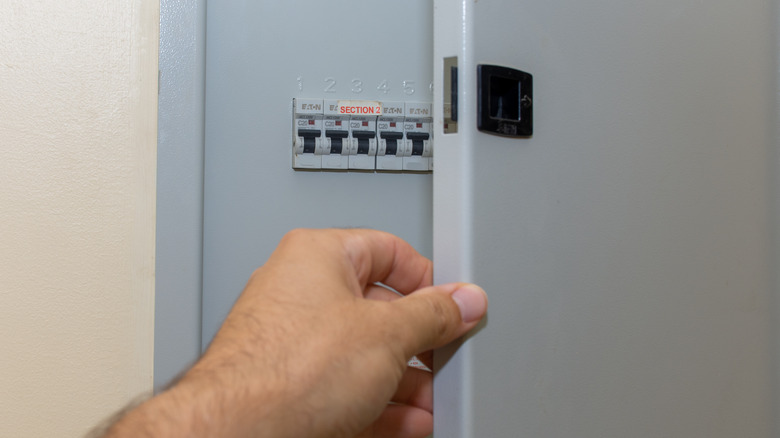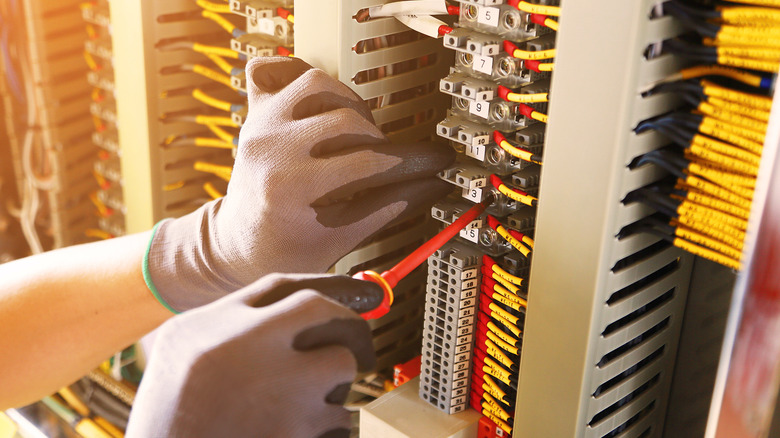Everything New Homeowners Need To Know About Circuit Breaker Boxes
Moving to a new home can be overwhelming, especially when it's your very first home. Having your own home means you have major financial responsibilities, but it also means you have the responsibility of understanding the many features of your home and how to utilize them properly. One of the most important features of your home is its power, which is organized and controlled through your circuit breaker box.
According to Galvin Power, a circuit breaker box is a single, organized location that gives you access to all the main power lines of your home. This means that from your circuit breaker box, you will be able to turn on or turn off a specific outlet or all the electricity within your home with the simple flick of a switch. With the amount of power a circuit break box holds, it's important to understand how to properly use it. Helping you properly care for and understand your home, House Digest is here to provide you with everything you need to know in regard to your home's circuit breaker box.
Why are circuit breaker boxes important
As mentioned before, a circuit breaker box is an organized location where you can access all the major power lines running through your house. Other than giving you access and control over these major power lines, circuit breaker boxes also play an important role in the functionality and protection of your home.
Express Electrical Services states that one of the main objectives of your circuit breaker box is to disrupt the flow of power through one of your major power lines if something is wrong with the current. For example, an overload or even a short current. Although this may feel inconvenient at times, it's a protective feature that is very important to your home. Cutting currents that act beyond their normal measure can prevent damage to the overall electrical circuit and any electronic appliances that may be plugged into that circuit. Especially when dealing with an overload of electricity, circuit breaker boxes can also prevent the overload of heat and sparks that have the potential of electrocuting things within your home or even starting a fire.
Features of a circuit breaker box
As soon as you open your circuit breaker box, you will notice a series of knobs and switches that allow you to safely access the many features your circuit breaker box has to offer. D&F Liquidators explains six of the main features you can access within your circuit breaker box.
The first main feature that D&F Liquidators mentions is the main circuit breaker. The main circuit breaker is the main on-and-off switch that allows you to control the power in your home. It also has the power to shut currents down if they are deemed a potential threat. After the main circuit breaker, there are two different types of standard breakers: single-pole and double-pole breakers. Single-pole breakers are single switches in your circuit breaker box that can only handle up to 120 volts of energy, which are the most common breakers in your house. On the other hand, double-pole breakers can handle up to 240 volts, which is meant for your large home appliances, like your water heater, stove, or washing machine.
Another feature in your circuit breaker box is arc fault circuit interrupters, which help further protect your home from fires and electrocutions. Sub-panels allow you to add more circuits to your circuit breaker box. Finally, bus bars allow the main current to break off into smaller currents that power different areas of your house.
Determining your circuit breaker box size
The size of your circuit breaker box plays a rather large role in the amount of electricity you can use within your house. Hunker explains that the larger your circuit breaker box is, the larger your electronic usage can be.
To determine the proper size your circuit breaker box should be, start by finding the light and receptacle watts you need to power your home, which can simply be found by multiplying the square footage of your home by three. To this number, you will then need to add the wattage to run your kitchen, laundry room, and air conditioning and heating units. By adding all these together, you will get the total wattage needed to run your home, which should then be divided by 230 to find the total amperage needed in your circuit breaker box. With this number, you can find exactly how large you need your circuit breaker box to be.
Safety during use
Usually, you only go into your circuit breaker box when there is an electrical issue within your house. Especially when it comes to an electrical problem, you must use your circuit breaker box with precautions due to the severe damage electricity can cause when not properly controlled. D&F Liquidators recommends several precautions you can take to make using your circuit breaker box safer for you and your home.
First and foremost, you should always know which switch works which outlet within your home. Some circuit breaker boxes already come labeled, but if it is not already labeled, flip the switches on and off to familiarize yourself with which switch controls which outlets. This process also ensures the circuit breaker box, in general, is functioning properly. When using your circuit breaker box, it's also important that your hands are dry due to the damage and danger of mixing electricity and water together. If for some reason, your circuit break won't reset your home's power, it's essential that you do not repeatedly reset the power breaker to get it to work. Finally, if there is ever an issue with your circuit breaker box, do not troubleshoot the issue alone if you do not have knowledge and experience because working with electricity can be dangerous and cause potential damage to your home.
Replacing your circuit breaker box
Just like other appliances within your home, after a while, you may need to consider replacing your circuit breaker box. Hiller claims that the electrical panel within your circuit breaker boxes should be replaced around every forty years; however, there are some signs you should look for that may require you to replace them sooner.
One of the clearest signs that you need to replace your circuit breaker panel is that your circuit breaker is constantly tripping. Your circuit breaker is not meant to interfere with your electricity unless it's manually changed or presents a danger to your home. This means that if your circuit breakers are interfering with your normal daily uses of electricity, it is time to replace your circuit breaker panel. If you see rust, smell burning, or notice that your circuit breaker box is very hot to touch, this is another sign to replace your circuit breaker panel. In fact, with these signs, you should attempt to replace the panel as quickly as possible to prevent possible damage to your electrical system and your home in general.
Lastly, if your circuit breaker box is generally old, it is always best to replace it with a newer model. Not only will it be safer for your home, but it will also accommodate and decrease electrical damage to newer pieces of technology you use around your house.
